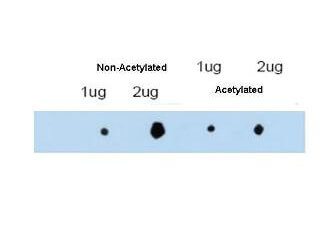Anti-ATDC (RABBIT) Antibody
ATDC Antibody
- SPECIFICATION
- CITATIONS
- PROTOCOLS
- BACKGROUND

| Host | Rabbit |
|---|---|
| Conjugate | Unconjugated |
| Target Species | Human |
| Reactivity | Human |
| Clonality | Polyclonal |
Application
| WB, E, I, LCI |
| Application Note | This affinity purified antibody has been tested for use in ELISA and western blotting. Specific conditions for reactivity and detection of ATDC should be optimized by the end user. Expect a band approximately ~66 kDa in size corresponding to ATDC by western blotting in the appropriate cell lysate or extract. |
| Physical State | Liquid (sterile filtered) |
| Buffer | 0.02 M Potassium Phosphate, 0.15 M Sodium Chloride, pH 7.2 |
| Immunogen | This affinity purified antibody was prepared from whole rabbit serum produced by repeated immunizations with a peptide corresponding to an internal portion of human ATDC protein around lysine 116. |
| Preservative | 0.01% (w/v) Sodium Azide |
| Gene ID | 23650 |
|---|---|
| Other Names | 23650 |
| Purity | This product was affinity purified from monospecific antiserum by immunoaffinity chromatography. This antibody reacts with over-expressed, acetylated and non-acetylated (at K116) ATDC protein. A BLAST analysis was used to suggest cross-reactivity with ATDC from human, horse, bovine, chimpanzee and macaque based on a 100% homology with the immunizing sequence. Partial reactivity is expected against rat and mouse ATDC based on 92% homology with the immunizing sequence. Cross-reactivity with ATDC from other sources has not been determined. |
| Storage Condition | Store vial at -20° C prior to opening. Aliquot contents and freeze at -20° C or below for extended storage. Avoid cycles of freezing and thawing. Centrifuge product if not completely clear after standing at room temperature. This product is stable for several weeks at 4° C as an undiluted liquid. Dilute only prior to immediate use. |
| Precautions Note | This product is for research use only and is not intended for therapeutic or diagnostic applications. |
| Name | TRIM29 |
|---|---|
| Synonyms | ATDC |
| Function | Plays a crucial role in the regulation of macrophage activation in response to viral or bacterial infections within the respiratory tract. Mechanistically, TRIM29 interacts with IKBKG/NEMO in the lysosome where it induces its 'Lys-48' ubiquitination and subsequent degradation. In turn, the expression of type I interferons and the production of pro-inflammatory cytokines are inhibited. Additionally, induces the 'Lys-48' ubiquitination of STING1 in a similar way, leading to its degradation. |
| Cellular Location | Cytoplasm. Lysosome. Note=Colocalizes with intermediate filaments |
| Tissue Location | Expressed in placenta, prostate and thymus. |

Thousands of laboratories across the world have published research that depended on the performance of antibodies from Abcepta to advance their research. Check out links to articles that cite our products in major peer-reviewed journals, organized by research category.
info@abcepta.com, and receive a free "I Love Antibodies" mug.
Provided below are standard protocols that you may find useful for product applications.
Background
Ataxia-telangiectasia group D-associated protein (ATDC), also called tripartite motif-containing protein 29 (TRIM29), is a novel Histone deacetylase (HDAC) associated protein. Its function is tightly regulated by HDAC. ATDC Lysine 116 (K116) is acetylated and has a significant functional role in regulating cell survival and tumorigenesis. ATDC is expressed in placenta, prostate and thymus, and is over expressed in pancreatic and cervical tumors. Its function in tumor cells is not fully understood. It is constitutively phosphorylated by PKC on serine/threonine in A431 cells. The ATDC gene product is one of a group of proteins that share multiple zinc finger motifs and an adjacent leucine zipper motif. These proteins have been proposed to form homo- or heterodimers involved in nucleic acid binding, consistent with the fact that many of these proteins appear to be transcriptional regulatory factors involved in carcinogenesis and/or differentiation. The likelihood that the ATDC gene product is involved in transcriptional regulation could explain the pleiomorphic characteristics of AT, including abnormal cell cycle regulation.
If you have used an Abcepta product and would like to share how it has performed, please click on the "Submit Review" button and provide the requested information. Our staff will examine and post your review and contact you if needed.
If you have any additional inquiries please email technical services at tech@abcepta.com.













 Foundational characteristics of cancer include proliferation, angiogenesis, migration, evasion of apoptosis, and cellular immortality. Find key markers for these cellular processes and antibodies to detect them.
Foundational characteristics of cancer include proliferation, angiogenesis, migration, evasion of apoptosis, and cellular immortality. Find key markers for these cellular processes and antibodies to detect them. The SUMOplot™ Analysis Program predicts and scores sumoylation sites in your protein. SUMOylation is a post-translational modification involved in various cellular processes, such as nuclear-cytosolic transport, transcriptional regulation, apoptosis, protein stability, response to stress, and progression through the cell cycle.
The SUMOplot™ Analysis Program predicts and scores sumoylation sites in your protein. SUMOylation is a post-translational modification involved in various cellular processes, such as nuclear-cytosolic transport, transcriptional regulation, apoptosis, protein stability, response to stress, and progression through the cell cycle. The Autophagy Receptor Motif Plotter predicts and scores autophagy receptor binding sites in your protein. Identifying proteins connected to this pathway is critical to understanding the role of autophagy in physiological as well as pathological processes such as development, differentiation, neurodegenerative diseases, stress, infection, and cancer.
The Autophagy Receptor Motif Plotter predicts and scores autophagy receptor binding sites in your protein. Identifying proteins connected to this pathway is critical to understanding the role of autophagy in physiological as well as pathological processes such as development, differentiation, neurodegenerative diseases, stress, infection, and cancer.


